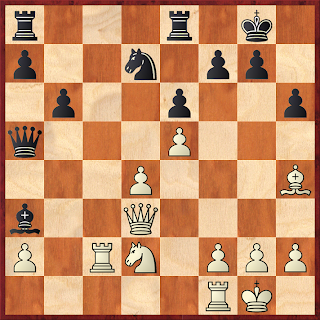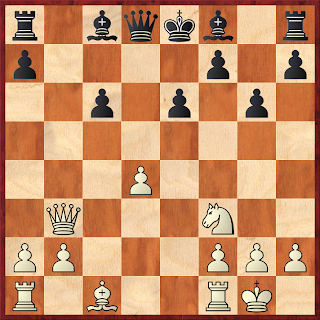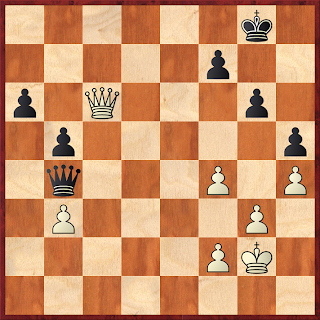Before the start of the game, one of my very good friend Atul Dahale, gave me a call and said Carlsen will win today! I said lets make a bet! I believe in Gelfand's capabilities with white pieces. He will atleast make a draw! And we made a bet that the winner gets any chess book he likes from the loser!
WHITE: BORIS GELFAND.
BLACK: MAGNUS CARLSEN.
1. d4 Nf6 2. c4 e6 3. Nf3 d5 4. Nc3 Nbd7 5. Bg5 c6 6. e3 Qa5
The Cambridge Springs Variation.
{The Cambridge Springs variation which was very popular years ago most notably in Capablanca-Alekhine Havana match of 1927. but this is after a long time that this line has made a comeback in top level chess.} 7. cxd5 (7. Nd2 is by far the main move. Bb4 8. Qc2 O-O 9. Be2 e5 (9... dxc4 10. Bxf6 Nxf6 11.
Nxc4 Qc7) 10. dxe5 Ne4! With a very complicated position.) 7... Nxd5 8. Rc1 {this isnt played very frequently.
the main moves are Qd2 and Qb3} (8. Qd2 Bb4 9. Rc1 c5)
(8. Qb3 Bb4 9. Rc1 c5 10. a3 But white can make a very natural move like 8. Qc2?
Black now gets a huge advantage. How?
Bb4 9. Rc1 . Qxa2 ! and black is simply winning!8... Nxc3 9. bxc3
Would you capture the pawn on a2?
Ba3 (9... Qxa2 I see nothing wrong per se with this pawn capture but it just gives white a pleasant initiative for the pawn with 10. Bd3 Something that Carlsen is not aiming for.)
10. Rc2 b6 this idea with b6 has been played in just 2 games before. so we can assume that Gelfand is already in terra incognitia. 11. Bd3 Ba6 12. O-O Bxd3 13. Qxd3 O-O
Would you chose here e4 or c4?
14. e4 (14. c4 was a safer way to expand. Because when you play e4 with the idea of playing e5 then you are signalling to black that you want to finish him off in the middlegame because any endgame would be advantgeous to black due to the queenside pawn majority and i think such a strategy is usually not so successful against a super calculator like carlsen.But both moves are good.14... Rfe8 15. e5
Have a look at this pawn structure and then the one below from a totally different opening.
QUEENS INDIAN VARIATION. SIMILAR PAWN STRUCTURE.
{this position reminds me of petrosian variation in queens indian which goes like1. d4 Nf6 2. c4 e6 3. Nf3 b6 4. a3 Bb7 5. Nc3 d5 6. cxd5 Nxd5 7. Qc2 Be7 8. e4 Nxc3 9. bxc3 O-O 10. Bd3 c5 11. O-O Qc8 12. Qe2 Ba6 13. Rd1 Bxd3 14. Rxd3 Re815. e5
The Queens Indian Pawn structure, doesnt it resemble the game structure! This is a good way to learn how to play different openings according to me. Making the study of pawn structure.
h6 16. Bh4 c5 17.Nd2 cxd4 18. cxd4 (18. Nc4 Nxe5!)
Nc4 is a threat now, so will you retreat your bishop or are you as ambitious as Magnus?!!
18... Rac8! {Iron nerves! Black can see Nc4 but calculates that nothing bad is happening.} 19. Nc4 Qb5! 20. f4 {Gelfand wants to just crash through Carlsen with f4-f5.}
(20. Qxa3 Rxc4 21.Rxc4 Qxc4 22. Qxa7 Qxd4 23. Bg3 Qd5 $17) (20. Rd1 so that now Na3 is possible
but black is just in time to save everything. Bf8)
f5 is a threat, what does Carlsen do?
ignore it! 20... Rc7! {I think to make such a move, you need nerves of steel. what is carlsen doing? he is
keeping the tension. and in this battle of keeping tension he is better than most of the other chess players mainly because of his calculating ability and physical fitness.Any normal player would have retreated the bishop.} 21. Qxa3 (f5 Rec8 fe6 fe6) Rxc4 22. Rxc4 Qxc4 23. Bf2
How do you assess the position.
{Now we reach a position where it seems to me that the short term edge is with white.mainly because he is threatening the a7 pawn and also because he is going to control the c file with Rc1. However if you look deeply, all the long term static advantages lie with black. Queenside majority for black, A bad Bishop for
white and good outposts for black knight. Such positions are extremely dangerous when you play with a computer or Carlsen because they wont blunder and then they will slowly use their trumps to unravel and beat you! Thats exactly what happens in this game.Some might say position is equal but i think white is facing some difficulties)} Qc7 24. Rc1 Qb7 25. Qd6
Do u like tension? Well then try to keep it in this position!
26. g3 (26. Rc7 Qe4 27. g3 Qb1+ 28. Kg2 Qxa2 29.Qc6 Rd8 30. Qb7 Rxd4 31. Rxf7 Rd2 32. Rxg7+ Kh8 33. Rf7 $3 Rxf2+ 34.Kg1 Qb1+ 35. Kxf2 Qc2+ $11 36. Kg1 Qd1+ 37. Kg2 Qe2+ 38. Kh3 Qh5+ = a long computer like variation.)
26...Rc8 27. Rxc8 Qxc8 28. d5 {atleast removing one pawn from the dark square and
giving more scope to his B.} exd5 29. Qxd5 g6 30. Kg2 Ne6
After the game my father said, A knight is always better than a Bishop in an endgame!!
because the Bishop can take active part in the game only from d4 and c5 and
both the squares are guarded by the knight.}
31. Qf3 Kg7 {f5 is not possible yet because of Ng5} 32. a3 h5 33. h4 {Prevents Ng5 in reply to f5. So now the threat is f5.} (33. h3 i think was more flexible not fixing the structure. but in any case black is slightly better.) 33... Qc2 34. Qb7 Qa4 35. Qf3
f5 is a threat now. How should Carlsen make progress?
Let me tell you what happened here. I felt that black was better here. but the threat of f5 was irritating, so i tried to think and think but didnt find anything much. But i wanted to know the truth and so i switched on Rybka. It showed a small advantage to black only if he played b5 allowing white to carry out f5. I said to myself. this is a computer line and no human can dare play this move. If Carlsen did make this move b5 then in my eyes he would rise to a position of really a chess engine! and guess what after 5 minutes Carlsen had made his move b5!! {it takes immense guts to allow a move like f5.} 36. f5 gxf5 37. Qxf5 (37. Qxh5 Qc2) 37... Qxa3 38. Qxh5 a5
How can black king feel so safe inspite of no pawn cover?
{it might seem silly to push your queenside pawns when your king is so exposed. but here we have a perfect case of harmonius setup. the pawn defends the knight.the king defends the pawn and the pawn controls the light square g6 and the knight controls the dark square g5. if you notice, the three pieces there are like trimurti. each one individually not so strong but together they are an armor which cannot be breached.}39. Qg4+ Kf8 40. h5? {the last move of the time control and a bad move by gelfand. now he
cannot use that square to give checks and hence his positions becomes quite
dangerous.} (40. Qh5 Ke8 41. Qh8+ Qf8 42. Qh7 b4)
Last move of time control. time to make the most accurate move.
41. Qe4 (41. Qh4 Qc6+ 42. Kg1 Qf3 43. h6 Kg8) 41... b4! {so precise is this man!} 42. Be3 (42. Qa8+ Kg7 43. h6+ (43. Qxa5 b3) 43... Qxh6 44. Qxa5 Qd2-+)
What is the way to break the perpetual check set up of white?
42... Qc7! so that later on queen can interpose itself with Qd8! (42... Qc8! 43. Qh7 Qc6+ 44. Kf2 b3 45.Qh8+ Ke7 46. h6 b2 47. h7 Qc2+ 48. Kf3 Qf5+ 49. Kg2 b1=Q 50. Qf6+ Qxf6 51.exf6+ Kxf6 52. h8=Q+ Ke7-/+ was maybe more accurate) 43. Qa8+ Kg7 (43... Ke7 44. h6) 44. h6+ Kh7 45. Qe4+ Kg8! (45... Kh8 46. Qa8+ Qd8 47. Qb7 attacks the f7 pawn.so black will have to repeat. Qc7 48. Qa8+ Kh7 49. Qe4+ Kg8 and we are back on track.) 46. Qa8+ Qd8
Will you take the queen?
47. Qxd8+ ? {horrible decision. once again as i said, Carlsen's opponents are unable to withstand the pressure.But i think Gelfand has twice made this mistake of taking the queen. Once against Aronian Qb3 in round 2 and now against Carlsen in round 3. his future opponents can smell something fishy here!! 47. Qb7 was a better defense but the fact that black has the advantage is out of question. Qd3 48. Qa8+ Kh7 49. Qf3 Qc2+ 50. Kf1 Qg6 keeping control. 51. Qb7 Qd3+ 52. Kf2 Nd8 and now the queenside pawns are ready to roll.)
47... Nxd8 48. Kf3 a4 49. Ke4 Nc6 50. Bc1 Na5 51. Bd2 (51. Kd3 Nb3 52. Kc2 Nxc1 53. Kxc1 Kh7) 51... b3 52. Kd3 Nc4 53. Bc3 a3 54.g4
The game is almost over but you have a chance to play better than what Carlsen did!!
Kh7 wins easily but even faster was 54... Ne3! Kudos if you got it! your rating will soon be 2900!! 55. g5 Kg6 56. Bd4 b2 57. Kc2 Nd2 0-1So now i do have to give Atul a chess book but i am so glad that Carlsen won this game! For i know that i witnessed live move by move one of the best endgame squeezes ever seen!





















































